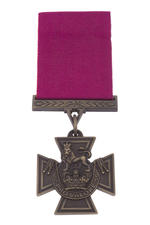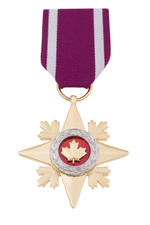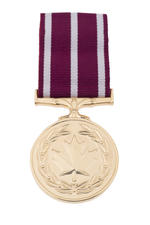Military Valour Decorations are national honours awarded to recognize acts of valour, self-sacrifice or devotion to duty in the presence of the enemy. The decorations were approved by Her Majesty Queen Elizabeth II in 1993. They consist of the Victoria Cross, the Star of Military Valour and the Medal of Military Valour.
A person is eligible to be awarded a Military Valour Decoration if that person, on or after January 1, 1993, was a member of the Canadian Armed Forces, or a member of an allied armed force that was serving with or in conjunction with the Canadian Armed Forces. The Decorations may be awarded posthumously.
Military Valour Decorations Regulations - Canada Gazette, February 26, 1994, pp. 1439 to 1444
Victoria Cross (V.C.)
The Victoria Cross was created by Queen Victoria in 1856, and was awarded to Canadians in all wars until 1945. The Canadian Victoria Cross retains the same design and the same awarding criteria as the British Victoria Cross.
The Right Honourable Michaëlle Jean, former governor general of Canada, unveiled the Canadian Victoria Cross at Rideau Hall on Friday, May 16, 2008, in the presence of the Prime Minister of Canada, parliamentarians, members of the Canadian Armed Forces, veterans and other distinguished guests.
The Victoria Cross recognizes the most conspicuous bravery, a daring or pre-eminent act of valour or self-sacrifice or extreme devotion to duty, in the presence of the enemy.
Description of the medal
|
The Cross is a bronze straight-armed cross pattée, 38 mm across, with raised edges.
|
Star of Military Valour (S.M.V.)
The Star of Military Valour recognizes distinguished and valiant service in the presence of the enemy.
Description of the medal
|
The Star is a gold star with four points with a maple leaf in each of the angles:
|
Medal of Military Valour (M.M.V.)
The Medal of Military Valour recognizes an act of valour or devotion to duty in the presence of the enemy.
Description of the medal
|
The Medal is a circular gold medal:
|



